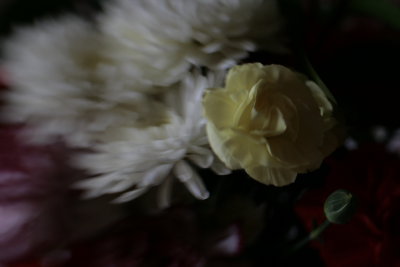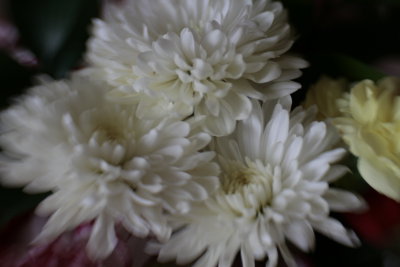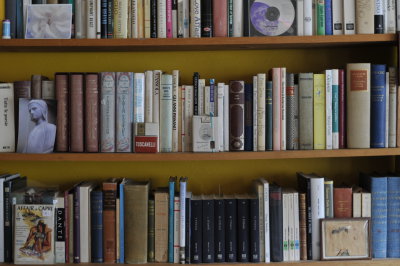ADJUSTABLE APERTURE ON 35MM OPTIC
Lensbaby Sweet 35 Optic
Just Clicks

By MIKE PASINI
Editor
The Imaging Resource Digital Photography Newsletter
Review Date: March 2011
If there has been one aspect of the design of Lensbaby products that was a little wanting, it would be the aperture design.
Marvel as we might at the little magnetic aperture disc snapping into position above the lens and levitating there until we pulled it out with the magnetic tool, there's nothing like simply clicking to change apertures.
We never made much of this in our reviews because changing apertures in a Lensbaby is a creative act. The aperture determines how much of the scene is in focus. Sure it affects exposure and depth of field, but in a Lensbaby it doesn't just affect focus, it determines it.

New & Old. Sweet 35 optic (left) compared to Double Glass Optic that uses the discs.
Generally speaking, we'd use an aperture disc of f11 to minimize the effect with handheld shots and one of f4 or wider to narrow the focus to a spotlight-like circle.
The problem, though, was that this relied mostly on our ability to imagine how large a circle of focus each aperture would provide. Or, alternately, try each one to find out what it did.
You can get pretty good at swapping out aperture discs but to an innocent bystander it still looks like work. And that's an impression you want to avoid whenever possible.
Enter the Sweet 35.

Not Included. The magnetic tool (top left) inserts and removes the aperture discs on other optics. Apertures are built into the Sweet 35.
In an impressive adaptation of the Composer housing design, Lensbaby has been able to concoct an optic with an internal 12-blade aperture controlled by an aperture ring on the front of the piece.
That's trickier than it sounds because as you focus the lens with the Composer housing, the optic shrinks inside and extends outside the Composer opening. You not only have to be able to grab the aperture control but you have to be able to see what you have set it to.
So the Sweet 35 aperture ring is about half an inch wide with numerals printed on the outside edge so they remain visible when the optic retreats into the housing.
Not that you'll be recording aperture settings. Instead, we suspect you'll be focused on the other end of the camera to see how an aperture change affects the focus area of your scene.

Close Focus. Sweet 35 gets within 8 inches on the Composer.
The 35mm focal length itself is a nice choice, too.
For subframe sensor cameras, 35mm is the new normal. Pop one on your camera and the view takes no mental gymnastics to take in. It looks about the way you thought it would. Nothing closer than it appears in the mirror. Nothing further away.
The Sweet 35 focuses as close as 7.2 inches in the Composer housing and opens as wide as f2.5. In contrast, Canon's 35mm f2 focuses as close as 9.6 inches. And Nikon's popular new 35mm f1.8 G focuses as close as a foot.
Neither of these representative 35mm primes, of course, is a selective focus lens. A selective focus lens narrows the circle of focus in a scene as you open the aperture, much as a depth of field in a normal lens becomes more shallower as you open the aperture.
SPECIFICATIONS | Back to Contents
- Focal Length: 35mm and the widest selective focus optic in the Optic Swap System (the Fisheye at 12mm is the widest, but is not selective focus)
- Focus Distance: When mounted in the Composer is 7.5 inches to infinity. On the Scout it's 6.5 inches to infinity. On the Muse and Control Freak it's 3.0 inches to infinity.
- Aperture: 12-blade adjustable aperture
- Aperture Range: f2.5 to f22
- Type: Selective focus optic (as you open the aperture, focus constricts). At f2.5 the sweet spot is about 15 percent of the total image area on APC-C sensors, growing to 40 percent at f22.
- Construction: Four multi-coated glass elements, in three groups. The front element is not a flat protective piece but part of the optical system.
- Threads: 46mm front threads
- Price: $180
COMPATIBILITY | Back to Contents
The Sweet 35 is compatible with the Lensbaby Composer, Scout, Muse, and Control Freak lens housings.
It is not compatible with the Composer with Tilt Transformer Micro Four-Thirds housings or current 37mm Lensbaby accessories.
We first mounted the Sweet 35 in a Lensbaby Composer for Canon EF. Of course we didn't do it correctly the first time, so we resorted to the thorough User Guide PDF available on the Lensbaby site.

Alignment. Note the bar below the solid dot at f2.5. That pair aligns to the open dot on the Composer. Then just turn toward the solid dot to lock the element in.
The first thing to do is rotate the Composer's focusing ring so the installed optic is as far forward as possible. That makes it accessible to the Optic Swap Tool, otherwise known as the cap of the Sweet 35 case.
A counter clockwise turn unlocks the installed optic after you've inserted the tool's three prongs into it. You can slip a finger into the installed optic to pull it out or turn the housing upside down to let it fall free.
To mount the Sweet 35 in the housing, you first have to open its aperture all the way. Since the aperture ring is on the front of the optic and you use the front of the optic to lock it into the housing, you want to be at the right end (the open end) of the aperture scale. There's a white bar on the Sweet 35 that aligns with the white dot under f2.5 to confirm you're in the right place.

Ready for Action. The Sweet 35 in the Composer on a Canon dSLR.
The white dot aligns to the open dot on the face of the composer, too, when you insert the Sweet 35 into that housing.
With the dots aligned, you simply turn the Sweet 35 clockwise until it aligns with the solid white dot. It's a good idea to keep the Composer's solid white dot at noon on the housing because it indicates the active f-stop, too.
If you did it right, the outer ring of the Sweet 35 should be exposed outside the Composer housing. As you focus the housing, it shrinks back in but the numerals for the f-stops should remain visible.
Removing the optic requires rotating the focus ring to bring it forward, aligning the hollow dot of the Sweet 35 (near f22) to the hollow dot of the Composer, pushing in slightly and turning counter-clockwise until the hollow dot on the Sweet 35 aligns with the solid dot on the Composer.
APERTURE CONTROL | Back to Contents
So what does the aperture control? Just as the aperture on a normal lens controls depth of field, increasing what's in focus as you stop the lens down, the Sweet 35 increases what's in focus as you stop down.
But the Sweet 35 changes what's in focus in the plane of focus, rather than changing the number of planes in focus as a normal aperture.
It turns focus into a spotlight you can aim at your subject and expand or contract as you like.
TILT CONTROL | Back to Contents
Mounted in any housing but the Scout, the Sweet 35's focus area can be moved around the scene by tilting the housing. As Lensbaby's documentation notes, "A little tilt goes a long way." On subframe sensors you can throw the sweet spot out of the frame. And full frame sensors may exhibit slight vignetting.
One good way to get comfortable with this is to practice with an aperture open to about f4. The restricted focus spot is easier to find and it's easier to see it move around the scene as you tilt.
CANON TEST SHOTS | Back to Contents
Here are a few test shots using the Sweet 35 on a Canon dSLR. All were taken in natural light. To compare images, just roll your mouse over the various f-stops. Click on an f-stop to set the image (or just roll off the f-stop).
Sweet 35 on Canon
NIKON TEST SHOTS | Back to Contents
Here are a few test shots using the Sweet 35 on a Nikon dSLR. All were taken in natural light. To compare images, just roll your mouse over the various f-stops. Click on an f-stop to set the image (or just roll off the f-stop).
Sweet 35 on Nikon
Judging Focus. One thing that immediately struck us was that changing the aperture changes the light reaching the viewfinder. At small apertures, seeing well enough to focus manually can be a challenge.
But it's even a challenge at large apertures. As we explained in Using Fast Primes With Live View in the Aug. 27, 2010 Newsletter:
"The big problem, though, is that it's just impossible to judge focus wide open with a fast lens. Why? Because the focusing screen wasn't designed for lenses that fast. Our widest apertures, we noticed, are all about the same brightness. When f1.8 is as bright as f4, you aren't seeing what's in focus at f1.8. The focusing screen's microlenses show more depth of field than the lens sees."
So the captured scene can be a bit different than the scene you compose in the viewfinder. On three dSLRs we use, we can't see a difference in brightness at f4 and wider through the viewfinder.

The solution to this is either to carefully review your capture (enlarging to 100 percent to confirm focus) or use Live View to compose.
In fact, Live View is a really fun way to use the Sweet 35. Not only can you accurately set focus with the Composer, but you can see just what effect changing apertures has, especially at the wide end.

The rule of thumb here is that if you don't notice a brightness change with an aperture change when looking through the optical viewfinder, you aren't seeing focus at the wider apertures. As the Newsletter story observed, we found f4 to be about as bright as f2.5. Brightness did change between f4 and f5.6, though.
Using Flash. Artificial light presents its own problems. The sync speed of your shutter will be the limiting factor here. At 1/200 sec., the fastest sync on one of our dSLRs, we were constrained to f10 and smaller with a studio strobe we're testing set on only half power.

That would be true of any lens, of course, but it matters a lot more on the Sweet 35 because the aperture determines how wide focus is in your scene.
Outdoors. Our indoor test shots were all done on a tripod. For a little extracurricular fun, we took the Sweet 35 out for a walk.

We took the Sweet 35 on a hike up Twin Peaks after a day of storms and had fun shooting handheld. We found that f4 was a good place to start in Aperture Priority mode.
If the shot called for a larger circle of focus, it was no trouble to close down the aperture. If it called for a larger one, we opened up a bit, trying to keep the subject in the center of the focus area (which showed a bit larger than the capture, as we've explained).
Going back to f4 for the next shot prevented us from focusing on an area that would subsequently be out of focus if we opened the aperture.
We did look at the aperture ring to make sure we hit f4 but otherwise, it was easy to feel the aperture detents and the ring itself moves smoothly. Of course, there's no reason to hit the detents. You can certainly set the aperture between them.
It's impossible to imagine doing any of that with the magnetic ring apertures of other Optic Swap system optics.
Tilting the lens to move the focus circle to one side or another, one corner or another, was no problem and added to the fun. It's a different way to compose images and as much as we shoot on Twin Peaks, a refreshing change. We thought it might make an excellent way to use an older camera body, actually. Just mount a Composer and Sweet 35 optic on it for the occasional selective focus shot.
The only thing we missed with the review unit was a lens cap but Lensbaby informs us that the shipping units include one. We really enjoyed composing with the aperture ring, particularly with a dSLR that had Live View so we could see what apertures larger than f4 would do to the scene.
We also found the 35mm focal length just right for our subframe dSLRs. And the close focusing capability just added to the fun.
If you've invested in the Optic Swap system, the Sweet 35 is a confirmation of your intelligence. And it's never too late to demonstrate that. You can start quite nicely with the Sweet 35.



